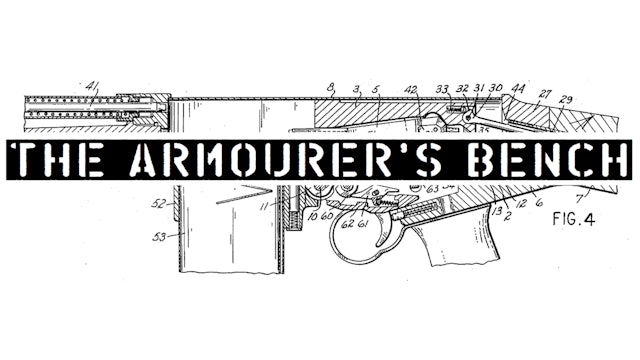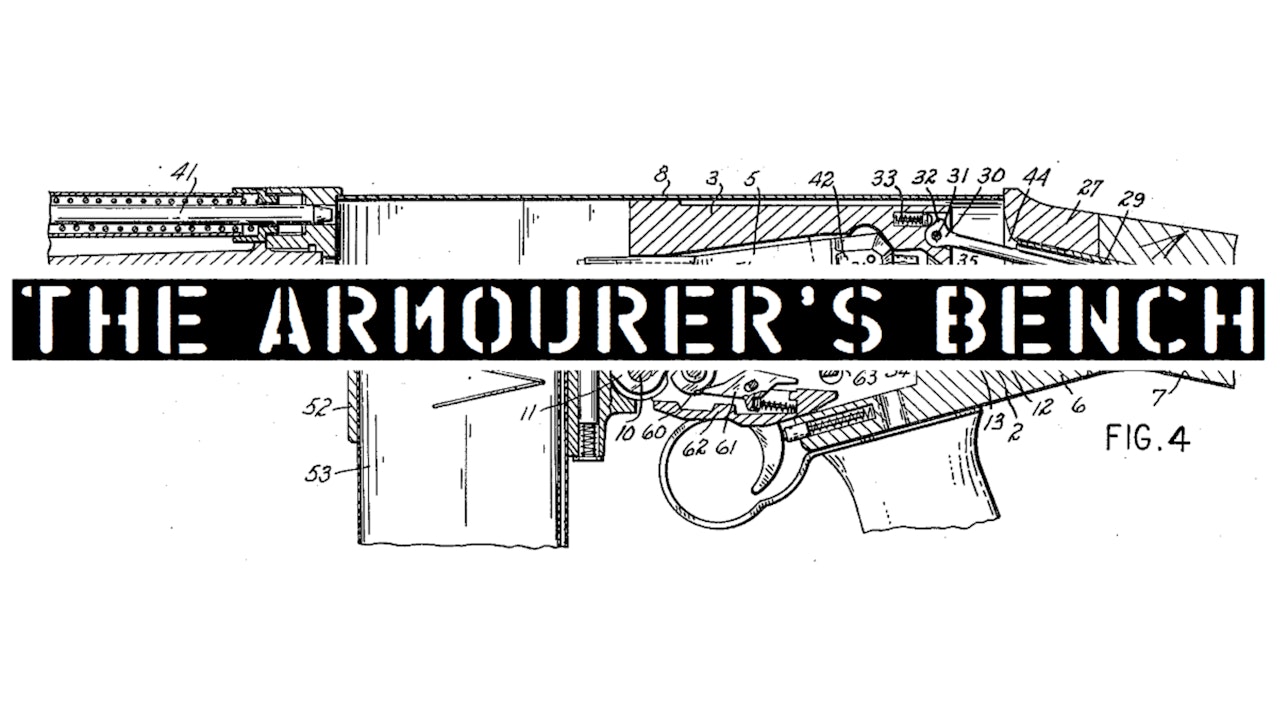The Armourer's Bench
The Armourer’s Bench is a multimedia project using both video and written articles to showcase the history of some of the world’s most interesting and important firearms. We will be bringing you detailed examinations of historic and modern small arms from around the world as well as occasionally looking at larger weapon systems. We will delve into the history, use and operation of the weapons using videos, articles and high resolution images to tell their story.
-
SAR-80
In the late 1970s Singaporean arms manufacturer Chartered Industries of Singapore (later known as ST Kinetics) sought a rifle to produce for domestic and export sale, they partnered with the UK's Sterling Armaments to produce an AR-18-inspired rifle, the SAR 80. Check out our detailed accompanyin...
-
Cutaway IWI Tavor TAR-21
Last week Matt attended SHOT Show 2020 and spotted a pair of Tavor cutaway demonstration guns at the IWI booth. Here's a quick video, put together on the fly, looking at the cutaway guns and showing how they illustrate the Tavor's working parts and operation. Check out the accompanying blog for s...
-
SA vz61 Blank Firing Pistol
Whilst Matt is off enjoying himself (and working) in Vegas at the SHOT Show, Vic looks at an interesting piece he finds in one of the surplus dealers he visits in Germany. The Czech Small Arms SA vz61 'Skorpion' blank firing pistol in 9mm knall (blank). A pistol manufactured for the reenactor and...
-
The 7-Barrel Nock Volley Gun
In 1779, James Wilson approached the Board of Ordnance with a formidable weapon - a 7-barrelled volley gun. Wilson's design would be manufactured by London gunmaker Henry Nock, whose name the gun subsequently took. The Nock Volley Gun saw service with the Royal Navy for around 20 years, although ...
-
Centrifugal Machine Guns
Harnessing centrifugal force these experimental centrifugal machine guns could throw thousands of projectiles a minute. How did they work? Why didn't the idea catch on? With some newly discovered archival footage, that actually shows one of the guns in action, Matt takes a look at what became one...
-
Chinese Type 64 Suppressed Submachine Gun
We're very excited to take a privileged look at the Type 64, an integrally suppressed submachine gun designed in China in the early 1960s. Taking several design elements from other Combloc small arms, it fired a special subsonic, spitzer 7.62x25mm round. Check out Matt's accompanying article abou...
-
Winchester Select-Fire Garand Prototype
In this episode Matt takes a look at an M1 Garand select-fire conversion developed by Winchester in the late 1940s. Likely chambered in an early version of 7.62x51mm NATO, the rifle is believed to be the work of Winchester (and later Ruger) lead engineer Harry H. Sefried. Be sure to check out Mat...
-
Early Johnson Rifle with Handguard & Bayonet Lug
One of the M1941 Johnson's most recognisable features is its exposed barrel. This rifle, an early military R-type gun, is unusual in that it has a traditional wooden forend and bayonet mount. This appears to have been an attempt to address one of the US Military's main concerns about the Johnson ...
-
The Art of Persuasion - Abram Games Exhibition at The National Army Museum
A few weeks ago I had the opportunity to visit the National Army Museum in London and check out their current exhibition, The Art of Persuasion, a look at the wartime work of graphic designer Abram Games. While you may not recognise the name you will probably recognise some of his impressive and ...
-
Recommended Reading - History of the Small Arms School Corps by Richard Fisher
It's been a while since we did a book review, but Richard Fisher's new book on the history of the Small Arms School Corps is well worth a look. If you'd like a signed copy you can contact Richard at; https://vickersmg.blog/about/contact/ Or purchase the book from the publisher Helion Books, direc...
-
BOMARC Surface-to-Air Missile
The Boeing Bomarc was the world’s first long-range surface to air missile and despite its shortcomings remain in service for a decade. It was an extremely ambitious project and is a Cold War weapon that few today are familiar with. In this video Matt looks at the development, operation and servic...
-
Browning Prototypes - Detachable Box Magazine Lever Action Rifle
In 1891, John Browning designed a new rifle that fed not from a tube magazine but from a box magazine. Box magazines were a relatively new concept with James Paris Lee leading the field. This one-of-a-kind Browning prototype uses the same locking mechanism as the Winchester 1886 and is in 'musket...
-
Vickers Gun Disassembly
The Vickers Gun is an iconic weapon, developed from the Maxim and adopted by the British in 1912. It served for over 50 years in conflicts all around the world. In this video, Richard Fisher of the Vickers Machine Gun Collection and Research Association shows us how to disassemble a Vickers. Big ...
-
Cut-Down SMLE - WW1 Tunneler's Gun
The myths surrounding the use of cut down Lee-Enfield during WW1 are fascinating. I recently had the chance to take a look at an example of a cut down SMLE, which differed slightly in that it still had its stock - which I think makes it a more practical weapon than a truly cut down rifle. In this...
-
Rifle No.4 Cutaway
We've covered a few factory and instructional cutways in the past and I personally love nothing more than a good cutaway so I always try and film any I get the chance to look at. This episode we're taking a look at a cutaway Lee-Enfield Rifle No.4. Check out the accompanying blog for this video h...
-
The Christie Amphibious Tank
Short but sweet. I found this short piece of footage while doing some archival research and it was too cool not to share. I features a demonstration of John Walter Christie's amphibious armoured vehicle - complete with firing demonstration of the vehicles 75mm gun! If you enjoy our work please co...
-
Why Wasn't the Winchester Repeating Rifle Adopted
Ever wonder why the Winchester repeating rifle wasn't adopted by 19th century military powers? As a case study in this episode Matt examines a British Army trials report from 1869 that evaluates a number of repeating rifle designs and talks about why rifles like the Winchester weren't more widely...
-
US Military Railway Guns In Action
During World War One massive railway guns were used to reach deep behind enemy lines and attack enemy infrastructure with both sides using the massive artillery pieces. In this episode Matt takes a look at some archival footage of America's massive railway guns ranging from 10 to 16 inches. Check...
-
Heckler & Koch HK33
In this episode we take a look at Heckler & Koch's first 5.56x45mm rifle, the HK33. Introduced in the late 1960s, the HK33 was Heckler & Koch's response to the emergence of the new 5.56x45mm round and FN's introduction of the FN CAL. While the HK33 wasn't adopted by West Germany it proved a popul...
-
Fort Clinch
Defending the strategically important Cumberland Sound at the very north eastern edge of Florida, work on Fort Clinch began in 1847. It remained unfinished during the Civil War and changed hands several times before it was finally completed 20 years after construction began. It was sporadically g...
-
British 6 pdr Anti-Tank Gun
The British QF 6-pounder AT Gun was introduced in 1942, joining the lighter 2pdr, the new gun was more capable of dealing with the increasing thickness of Axis armour. The 6pdr first saw action in North Africa and was used throughout the war in Europe and Asia. It also armed a series of British a...
-
WW1 2-Inch Trench Mortar
The British Army entered the First World War with no light mortars. As the stalemate of trench warfare set in and the effectiveness of German Minenwerfers became clear it was decided that trench mortars of various sizes would be needed. Nicknamed ‘plum pudding’ or ‘toffee apple’ mortars after the...
-
QF 2pdr Anti-Tank Gun
Introduced just before the beginning of WW2 the 2pdr AT Gun was more than capable of dealing with Axis tanks at the beginning of the war but as tank armour got thicker it became outgunned. Despite this the 2pdr remained in service and equipped a plethora of tanks and armoured cars including the V...
-
Webley MkIV - The 'Boer War Model'
Adopted by the British Army around the outbreak of the Second Anglo-Boer War in 1899, the Webley MkIV saw action through to the Great War. The last of the 4-inch barrel Webley's the MkIV proved to be a decent sidearm for both officers and enlisted specialists like gunners, NCOs and trumpeters. Ch...

























